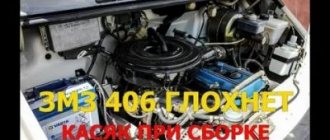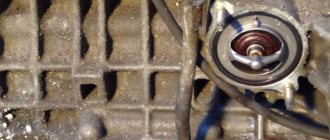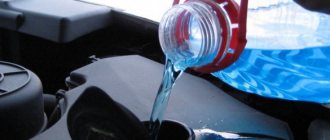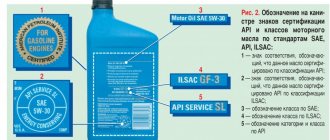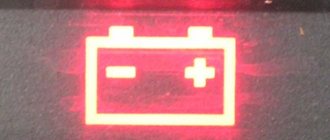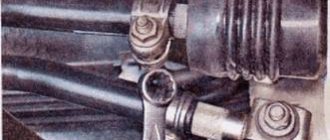I’ll share a little experience, in case it’s useful to someone)
I recently encountered this problem - I mean, I’m driving, I’m driving, I put it in neutral at a traffic light (or I’m squeezing the clutch), and my revs start to drop, the car practically stalls. This bullshit bothered me for quite a long time. That is, then no, then no again) In short, periodically my brain began to float. And then the singles disappeared completely. That's all! At least shit yourself. Whatever I tried, I couldn’t find the reason. Well, I think that's it, turn off the lights. We've arrived.
It's all up to chance, so to speak) I don't know why the hell I removed the terminal from the idle speed sensor, but when I put it back on, I noticed an interesting concept)) If I touch the contact on the sensor with the tip of the terminal, the idle ones appear, and if I put the terminal on, then disappear.
SHAITAN. Well, that's how it is! How the fuck?! In short, I pressed the contact, and everything worked again) Now, when some kind of crap starts with the electrics, I first move all the contacts))) What an adventure))
And also, I don’t know, whether it’s on the website or not, here’s a way to check the sensor: minus from the battery to the sensor body, plus to the sensor contact. If you hear a click, it works) If there is no click, replace it. And I think I even heard that it is better to buy a sensor with a red rubber band, and not with a black one. Better quality. But I don’t know for sure, I haven’t tried) So far the old one is shy)
The VAZ 2107 is not the best model among cars in its class when compared with foreign equivalents. However, thanks to its low price and accessible service, the car has been popular throughout the post-Soviet territory for many years. The car was produced from 1982 until 2014. That is, the oldest model is more than 30 years old. During such a period of operation, the owner will be able to encounter all types of faults and investigate most of the causes of problems.
After several years of operation, the VAZ 2107, as well as the almost identical model 2105, begins to show a new character with changes not for the better. Malfunctions associated with the power unit and its body kit are of a different nature, but are symptomatic:
- the engine stalls periodically;
- does not maintain stable speed;
- unstable operation at idle;
- hard to start;
- insufficient power;
- increased fuel consumption.
All malfunctions appear for two reasons: violation of adjustments or wear of parts.
Unstable operation of the injection engine
Usually expressed in a spontaneous change in engine speed. Observed while driving and at idle. The most common reason for low speed in VAZ2107/2105 injection units is the failure of the mass air flow sensor (mass air flow sensor).
This device controls the amount of air entering the engine. Based on this data, the ECU regulates the supply of a combustible mixture with the optimal fuel-to-air ratio under different engine operating modes. Accordingly, in the absence of this balance, engine speed begins to depend on the amount of incoming oxygen. That is, the wind blew - the speed increased, the speed died down - it decreased.
It is quite simple to make sure that it is the mass air flow sensor that is faulty. Disconnect the device connector and the ECU will switch to emergency mode. In this mode, fuel supply is controlled by the throttle position. If the car begins to behave more adequately, then the MVR is faulty. You can drive like this, but the power will drop slightly and fuel consumption will increase.
A failed mass air flow sensor cannot be repaired, except for contamination, so you can try to clean it.
Cleaning algorithm for DMVR VAZ2107/2105:
- Remove the sensor along with the protective casing.
- Unscrew the two screws and pull the sensor out of the base without touching the surfaces of the active element (straight, bent wire).
- Wash the casing with any dishwashing liquid.
- Using a bottle of cleaner for DMVR or for carburetor, based on alcohols (without acetone), carefully clean the surfaces.
- Pour generously 3-4 times, the liquid should drain.
- Dry the device.
- Reassemble the block in reverse order.
If the problem persists, you will have to buy a new device.
Unstable operation of the carburetor engine
The nature of the unstable speed of the VAZ2107/2105 engine with carburetors is the same as that of an injection engine, in the uncontrolled supply of air or fuel into the combustion chamber.
But in this case, the carburetor is responsible for preparing the combustible mixture. This is a completely mechanical device that is responsible for the optimal ratio of fuel to oxygen for different operating modes of the power unit.
Despite the fact that there are filters at the fuel and air inlets, they may not work efficiently, usually due to a long service life exceeding that specified in the maintenance standards. As a result, the carburetor jets become clogged with small particles.
Drivers with great experience do not stand on ceremony, they throw the VAZ2107/2105 carburetor into a bucket of gasoline for a day, then blow it out from all sides with compressed air and the carburetor seems to work normally. This is a normal solution, but flammable. Among the causes of engine malfunctions that are caused by carburetor failure are:
- displacement of the position of the adjusting screws due to shock or vibration;
- increase in the diameter of the jet holes due to wear;
- wear of the damper axis, limiting its travel;
- clogging of jets;
- failure of the float seal.
To determine the malfunction of the VAZ2107/2105 carburetor, and it will most likely be complex, start by checking the tightness of the float. To do this, remove it from the top carburetor cover (it needs to be removed). If there is gasoline in the float, throw away the float; if there is air, check in a bowl of water for bubbles. Let's say it passed the exam, then it is necessary to check the gap.
Lift the carburetor cover vertically. The gap between the float chamber and the carburetor wall should be 6.5 mm.
Install the carburetor cap and run the engine for 30 seconds. Remove the cover. The gasoline level should exactly coincide with the middle of the conical surface of the carburetor body. If this does not work, you should slightly bend the corner of the float rod.
Over time, air and fuel jets either become clogged or wear out. In the first case, they need to be cleaned and blown out. In the second case, you should check the throughput of the jets using a tank of water installed above the measured jet by 1 meter. They are connected by a tube. A volumetric flask is installed below. Measurements take place in units of cm3/min. Depending on the marking of the nozzle, the volume of liquid collected per minute in a volumetric flask should correspond.
It is much easier after 7-10 years of carburetor operation to buy a set of jets and replace them.
Those who use gas installations should know that a carburetor is not used when driving on gas. Over time, oxide forms inside dry jets, which clogs the fuel supply holes. A gasoline car may not start. It is recommended to use gasoline periodically.
Carburetor VAZ 2107
Why was the VAZ 2107 equipped with carburetor engines? There are many reasons for this: from the standard requirements of that time to the ease of operation of this type of installation. Throughout the entire production period of the model, two-chamber carburetor mechanisms were installed on the car. That is, two chambers are built into the device body in which the fuel-air mixture ignites.
Mechanism design
If we talk about the design of carburetors on the VAZ 2107, then they all have an indivisible cast body, the internal contents of which can be divided into three main parts:
- the top one (represents the carburetor cover and fuel fittings, that is, there are special connectors to which the fuel hoses are connected);
- middle (the body itself, in the cavity of which two internal combustion chambers and diffusers operate);
- lower (consists of such important elements as the float chamber and throttle valve).
The carburetor consists of more than 40 small parts and mechanisms
In the design of carburetors on the VAZ 2107, small details are of great importance. Each component of the system is aimed at performing its job, and therefore the failure of at least one part threatens to break the entire carburetor.
The following can be considered particularly capricious in the design of the device:
Jets. These are tubes with clearly aligned holes. There are fuel and air (for supplying gasoline and air, respectively). If the holes become clogged with dust or, conversely, wear out during operation, the throughput of the nozzles can be reduced or increased. In this regard, the carburetor will not be able to maintain the proportions when forming the fuel-air mixture. Float in float chamber. It is this device that determines the required level of gasoline to guarantee the quality of engine operation in any mode. If the float settings are lost, then the entire system experiences difficulties in preparing the mixture, since there may not be enough gasoline or, conversely, too much. Carburetor gaskets. As an element, gaskets are installed on the outside of the carburetor body to prevent overheating of the device and securely fix the device itself to the intake manifold
However, frequent driving on broken roads quickly wears out the gaskets, so it is recommended to pay attention to these elements every time you inspect the device. Acceleration pump. This is a special device whose function is to transfer the mixture from the chamber to the engine.
For reference
The standard equipment of the VAZ 2107 in the USSR and Russia included 1.6 liter carburetors. The maximum power of such an installation is 75 horsepower. The device consumes AI-92 fuel.
Minimum dimensions of VAZ 2107 carburetors:
- length - 16 cm;
- width - 18.5 cm;
- height - 21.5 cm.
The total weight of the assembled structure is about three kilograms.
The device has a die-cast housing and built-in elements
Purpose of the carburetor
The essence of any carburetor is to create a fuel-air mixture. To do this, the following processes occur in the device body:
- The throttle valve opens, through which a strictly limited amount of gasoline enters the cavity of the float chamber.
- The economizer also regulates the fuel dose, so only the amount of gasoline that the engine needs at the moment of operation enters the chamber.
- Through jets (special tubes with holes) gasoline is directed into chambers No. 1.
- Here the fuel is crushed into small particles and mixed with air particles: thus creating a fuel-air mixture, which is necessary for the full operation of the engine.
- If the car's speed increases, the second chamber can be used to create more mixture.
- The accelerator pump directs the finished mixture to the diffusers, and from there to the cylinders.
The carburetor is the “main assistant” of the engine
Carburetor adjustment
Adjusting the carburetor involves several steps:
- Adjust the position of the float as described above.
- Check and set the “quality” and “quantity” screws to the initial state. Screw them all the way and unscrew them 2-3 turns for the “quality” screw and 3-4 for the “quantity” screw.
- Connect a tachometer or auto tester to the “K” terminal of the ignition coil, and the second probe to the housing.
- Start and warm up the engine to a temperature of 90°C
- Use the “quality” screw to set the maximum idle speed. The gasoline supply increases when the screw is rotated counterclockwise.
- Use the “quantity” screw to set the speed higher, approximately 80-90 rpm.
- Using the quality screw, we determine whether these speeds are maximum; if not, then we repeat the procedure.
- If the position of the quantity screw does not affect engine speed, tighten the quality screw so that the speed drops by 800-900 rpm.
This carburetor adjustment may not be entirely accurate, but does not require special equipment.
Setting the float chamber level
This is the first step in adjusting any carburetor. It is on this part that the consumption and stability of the engine will depend.
The level must be at the nominal level set by the manufacturer, so it is very important to follow the technology
Setting the fuel level in the float chamber: I - carburetor cover; 2 — needle valve seat; 3 - emphasis; 4 - needle valve; 5 - locking needle ball; 6 - valve needle pull-out fork; 7 — float bracket; 8 - tongue; 9 — float; 10 - gasket.
The top cover of the carburetor is removed, but before that, you need to pump up the manual fuel pump to check the set level. The nominal level is the level of gasoline located on half of the inclined surface. If it is higher or lower, then adjust the float level by bending the adjusting antennae. The XX speed is also regulated by the float chamber.
To check, just put the cover on top, start the engine and immediately turn it off. Open the lid again and check the level. After this, you can move on to the next stage.
If the car stalls
An engine that suddenly stops not only creates an inconvenient driving experience, but also poses a safety hazard to the driver and passengers. There are several reasons.
Stalls at idle:
Stalls while driving:
- interruption of fuel or air supply due to a dirty filter;
- fuel pump malfunction;
- clogged carburetor jets;
- engine overheating.
When diagnosing a car whose engine stalls in the most unexpected places, it is better to start by checking the idle speed sensor.
It's easy to check its functionality. Dismantle the device without removing the contacts, or connect them after dismantling. Hold the device in your hands, place your finger on the cone needle and ask a friend to turn on the ignition. If you feel shocks, then install the device back. The idle speed sensor is OK.
EPH sensor is faulty
The idle speed economizer or idle speed sensor is located under the hood of the VAZ 2107 and is screwed to the side of the carburetor. It is a small cylindrical electromagnet screwed into the unit. On the back side of the valve there is a contact, the wire from which goes to the power circuit of the ignition switch.
EPHH control unit: 1 — block outputs; 2 - body; 3 - printed circuit board with microelectronic elements.
If the carburetor cannot be adjusted in any way or the VAZ 2107 does not idle, and the idle speed disappears very quickly or the engine is unstable, then it makes sense to start the engine and try to unscrew the valve a little. If the operation of the carburetor engine is restored, tighten the valve with a little force and try changing the amount of mixture. In 90% of cases, the carburetor starts working correctly again.
Another case is complete valve failure. To do this, you need to check it. You need to connect it directly to the battery. If clicks are heard, then the valve is working. Try screwing it into the carburetor and starting the engine. If successful, you need to look for a break in the electrical wiring and then you won’t need to adjust xx.
Not enough air
Often the car starts up well and runs on choke, but as soon as the choke is turned off, the engine stalls. This indicates only one thing - lack of air. Most likely the air jets are clogged. They need to be unscrewed and cleaned. Then check that the car should not stall without suction.
There are an incredible number of reasons for poor performance of car components with similar symptoms, but only a specialist with a set of professional diagnostic tools can figure them out. But if you feel confident in yourself, go for it, VAZ service centers are already waiting for you.
What to do if the idle speed of a VAZ 2107 jumps, is there any panacea for this? The fuel system causes a lot of trouble for owners, but one thing needs to be taken into account - it is not always to blame. For example, in carburetor engines with a classic ignition system, there is a high probability of contact group failure if there is instability in the idle speed. But with injection engines everything is somewhat simpler. And now about everything in more detail.
VAZ 2107 carburetor does not idle - what is the reason?
The concept of “no xx” on a VAZ 2107 carburetor means that in addition to unstable engine operation, it stops. It can occur immediately after starting, or it can occur later, giving the engine a chance to work.
The reasons for the lack of idle speed are as follows:
- Faulty forced idle economizer;
- Air leak;
- Incorrect ignition timing adjustment.
All these problems are accompanied by the fact that the carburetor cannot be adjusted. Therefore, first we will find out how to eliminate the causes.
Why is the engine speed unstable?
When it comes to the carburetor, there are several reasons:
- The carburetor is clogged, the movement of air and gasoline becomes impossible.
- The operation of the solenoid valve is disrupted - the winding is burned out or the nozzle is clogged.
- Fuel or air filters are clogged.
- Incorrect carburetor adjustments on VAZ 2107.
In most cases, the culprit is the solenoid valve. Its appearance is shown in the photo. It is necessary in the power system for the following purpose - it opens the fuel supply when the ignition is turned on and closes it when it is turned off. Consequently, the engine stops immediately after turning off the ignition.
The VAZ 2107 carburetor solenoid valve is a small device consisting of the following elements:
- Frame.
- Winding (one end connected to a metal body).
- A rod that acts as a valve that opens and closes the fuel supply at idle.
- Copper jet with holes. Please note that the jets are marked; there are several sizes.
The solenoid valve operates only when the ignition is on. If suddenly there is a break in the power circuit, you can temporarily connect the central wire of the device to the positive terminal of the battery. Just try to carry out repairs as soon as possible.
Why does the VAZ-2107 injector stall the engine at idle?
A working engine in a VAZ-2107, the injector should work if the car is started, constantly, regardless of whether the vehicle is in motion or idling. Reasons why the engine stalls at idle:
- the idle speed controller is not functioning well;
- the throttle valve, channels related to the carburetor, and injector are heavily contaminated;
- the idle jet is dirty;
- it's time to clean the fuel pump and air filter;
- The mass air flow sensor and the sensor that reads the throttle position have refused to function;
- The crankcase ventilation mechanism of the VAZ-2107 engine is clogged.
To fix these problems, you need to remove each part and thoroughly clean it from dust and dirt.
Assess the condition of the components; if it is far from ideal, there are chips and deep dents, it may be better to completely replace the old part with a new one.
Preparing to adjust the idle speed
If you do not plan to clean and disassemble the VAZ 2107 carburetor, then one of the tools you will need is a screwdriver. A device for measuring the speed (tachometer) is installed in the dashboard. But it’s worth getting a mixture quality indicator. With its help you can create an air-fuel mixture in ideal proportions. This article will talk about adjustment using this device.
Before starting work, you need to warm up the engine to operating temperature. Let us remember that this is a temperature of about 90 degrees. You also need to put the air purification filter in place to simulate normal engine operation. Make sure the float is adjusted correctly. The fuel level in the chamber must always be stable.
There are also many requirements for ignition and gas distribution. Be sure that all clearances must be correct, and the ignition timing must be adjusted for the gasoline used. And most importantly, open the air damper completely while making the adjustment. That's all, the preparation work is briefly summarized, now you can begin the idle adjustment procedure.
Installing a VAZ 2107 carburetor
To install the carburetor back, it is necessary to apply a new seal to the installation site, on which the carburetor itself is installed. Screw the nuts onto the four mounting studs to ensure a tight fit of the carburetor to the manifold:
- Then connect two thin hoses for ventilation and vacuum to the two fittings located on the top of the carburetor unit.
- Next, connect the fuel supply hose to the inlet valve. It is advisable to replace the clamp with a new one.
- On the opposite side, screw the hose to the “return” side.
- Then connect the EPHH wire to the solenoid valve.
- It is advisable to install the throttle return spring before connecting the air and throttle valves.
Setting the idle speed of the VAZ 2107
Carefully inspect the carburetor, there are several screws on it - the quality of the air-fuel mixture and quantity. It is with their help that we will now try to adjust the carburetor. Of course, not every driver has such a device as a gas analyzer. However, not everyone cares about the level of CO in the exhaust. For convenience, it is advisable to have a digital or dial tachometer. You can find how to connect it correctly in the corresponding article on our website.
So, start the engine and turn the quality screw. Listen to the engine, you need to stop at the moment when the crankshaft speed is at its maximum. After this, you begin to rotate the quantity screw and achieve a frequency of 1100. And the last step is to set the frequency to 800-900 using the quality screw. Please note that if necessary, the idle speed adjustment must be repeated.
What about the injector?
Everything is a little simpler here, since no adjustments are needed. The reason is that a smart on-board control system is responsible for everything. And specifically for idling - the regulator (IAC). Some may call it an idle speed sensor, but this concept is completely wrong. The fact is that there are two types of devices on injection cars - sensors (reading) and actuators. The idle air control is a stepper motor; it does not measure anything, but on the contrary, it opens and closes the air supply through a special channel.
A breakdown of the IAC can only be determined by external signs, and then only relatively. The fact is that the control lamp on the dashboard will not light up if the regulator suddenly fails. But if you feel unstable revolutions, or they have disappeared completely, and the engine jerks and stalls, then first of all, of course, it is worth checking the performance of the IAC. It is worth noting that sometimes the “Check” can light up when the IAC is faulty. This happens if the engine detonates. The knock sensor signals a malfunction to the electronic control unit.
IAC breakdowns
If you have a VAZ 2107 with an injection engine, then pay due attention to the condition of the vehicle systems. If the speed on an injection engine fluctuates, then you need to look first at the idle speed control. The fact is that the breakdown of such a mechanism as the IAC can lead to very sad consequences, including a traffic accident. Here are the main signs by which you can independently determine whether the regulator is broken:
- The engine begins to “live its own life” - the crankshaft rotation speed is constantly changing, sometimes decreasing, sometimes increasing. Consequently, the tachometer needle constantly floats.
- When you start a cold engine, the crankshaft speed does not increase, it fluctuates within a certain range.
- If you turn on powerful electrical appliances (for example, a car radio, low or high beam), the speed decreases and does not return to the set level.
- When you engage the neutral gear, the engine begins to stall if you do not apply the gas pedal from time to time.
These are the main signs that the regulator is faulty. In fact, any interruptions in the idle level are the first sign of a breakdown or minor defect in the IAC. But the time has come to diagnose it. It won't be difficult to do this.
Carrying out diagnostics
The simplest method is to measure the voltage at the block to which the regulator is connected. These are terminals D and A. When the ignition is turned on, a voltage of 12 V should be present on them. If the voltage is less than this value, it is worth looking at the battery and generator. It is quite possible that the battery is undercharged. In the same case, if there is no voltage at all, it is necessary to check the entire power circuit of the device and diagnose the ECU.
Set the multimeter to resistance measurement mode. Between pairs of terminals A and B, C and D, there should be a resistance of approximately 53 ohms. Remove the IAC and connect (with the ignition off) to the block. Then turn on the ignition and look at the behavior of the needle - it should extend completely when voltage is applied. If this does not happen, we can judge that the IAC is broken.
Sometimes simply cleaning the regulator helps. To do this, you can use sprays, of which there are sufficient quantities in stores. But in some cases, only replacing the device will help. Of course, this is not a DAAZ carburetor, the cost of the IAC will be many times lower, and there will be no problems with replacement. If, even after the replacement, the engine does not idle, it is necessary to fully diagnose the injector.

